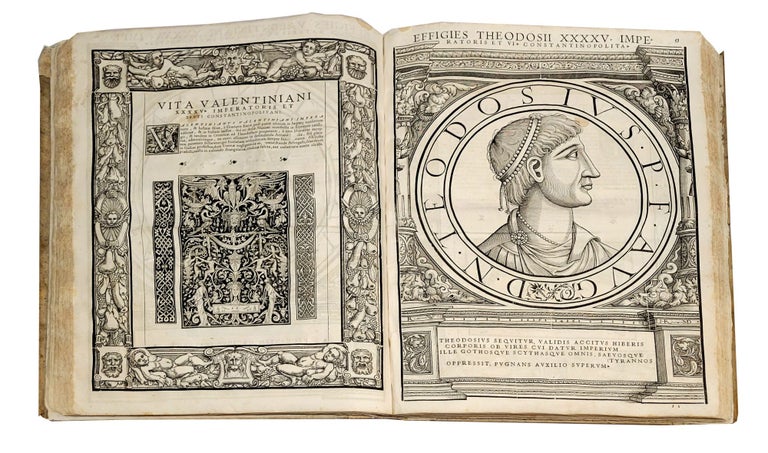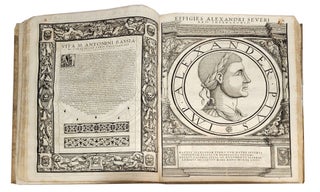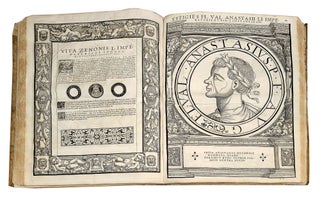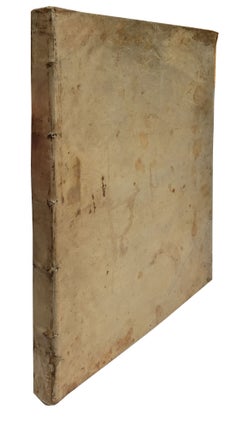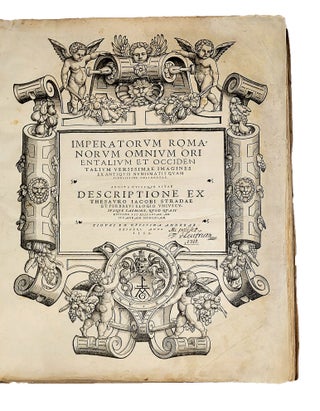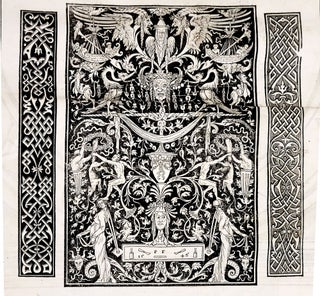Imperatorum romanorum omnium orientalium et occidentalium verissimae imagines
STRADA, Jacopo. Imperatorum romanorum omnium orientalium et occidentalium verissimae imagines. [5], 118, [1] ff., illustrated with a large woodcut title composed of a Renaissance frame of garlands and festoons of fruit and putti, attributed by van Elck to Jos Murer, cut by Christoph Schweitzer, and with 118 full-page woodcut portraits of Roman and Holy Roman Emperors, surrounded by richly decorated Renaissance architectural borders, cut by Rudolf Wyssenbach and Christoph Schweitzer after Hans Rudolf Manuel Deutsch. Plus, there are 248 woodcut designs of arabesques by Peter Flötner, several repeats. Folio, 460 x 355 mm., bound in contemporary flexible vellum preserved in a later slipcase. Zurich: Andreas Gesner, 1559.
Exceedingly rare first folio edition. The 118 medallion portraits measure a substantial 285 mm. (11 1/8") in diameter and are considered the work of Hans Rudolf Manuel Deutsch (1525-1571), who copied Strada's original drawings of ancient medals and coins from Strada's manuscript corpus: Magnun ac Novum Opus in the collection of Hans Jacob Fugger (see below). Several of the portraits are signed "HR MD" for H.R.M. Deutsch. The drawings were transferred onto woodblocks and printed by Rudolf Wyssenbach (fl. 1546-1560) and Christoph Schweitzer (fl. 1550-1562). These woodcut portraits are the largest ever cut for a book from a single block.
Throughout the 1540s Strada worked on his Magnum ac Novum Opus continens descriptionem imaginum, numismatum omnium tam Orientalium quam Occidentalium Imperatorum ac Tyrannorum, a thirty-volume illustrated manuscript of coins and medals of the Roman Republic from Julius Caesar up to Charles V. The work contains over nine thousand (9000) pen and ink drawings executed by Strada, one drawing per sheet, of medallion portraits based on ancient coins and metals. The work was financed by Hans Jacob Fugger who assumed ownership of the massive work. Strada reproduced 391 of these portraits in his Epitome Thesauri Antiquitatum, published in Lyon in 1553. These miniature portraits measure ca. 35 mm. in diameter.
In 1566 Duke Albert V of Bavaria purchased the Fugger collection of antiquities and his library. The Duke planned a museum and library of his own based on architectural drawings by Strada, however, construction was never carried out. During the Thirty Years War most of Strada's Magnun ac Novum Opus went to Gotha, where it remains in the Forschungsbibliothek. The last four volumes of the work were acquired by Thomas Howard, the Earl of Arundel, and they are now part of the holdings of the British Library. The text and commentaries, in ten manuscript volumes, are preserved in the libraries of the universities of Vienna and Prague.
These celebrated large portraits of rulers are nothing short of remarkable and reveal the cunning and powerful personalities of Byzantine and Roman Emperors beginning with Julius Caesar, through the Holy Roman Emperors, Kings and rulers ending with Charles V. Each portrait is accompanied by a brief historical sketch by Strada on the verso of the portrait leaves.
The Imperatorum Romanorum is enhanced by the addition of 248 arabesque ornaments by Peter Flötner (1485-1546), a Nuremburg goldsmith and artist, called "one of the most innovative sculptors and printmakers of the German Renaissance." In these sublime "mauresque" ornaments Flötner fused Arabic taste with Northern European scroll and strapwork designs. They first appeared in 1549 in a work entitled: Kunstbuch, cut by Rudolf Wyssenbach and published by the same printer as our volume in Zurich. One of Flötner's arabesque woodcuts: Upright Ornamental Panel with Grotesques and Foxes, is widely considered to be one of the most expressive ornament designs of the Renaissance. It appears on leaf 50 verso of this work. It has been posited that Flötner produced these arabesques as a models for contemporary craftsmen working with majolica, furniture, glass and ceramics. His monogram and the date 1546 appear on the verso of p. 50.
"In 1559 a really superb example of this sort of picture book was published at Zurich by Gessner. This great atlas called Imperatorum Romanorum Imagines with portrait heads by Wyssenbach and Schweitzer, borders by Wyssenbach and Deutsch, and arabesque panels by Peter Flötner… the borders are sumptious… the arabesques are among the most ingenious of this century, and the portraits are often remarkably designed with the greatest freedom and rare tact in the use of conventions for hair, beards, garlands, etc." (Douglas Percy Bliss, A History of Wood-Engraving, Woodcuts in the Sixteenth Century, p. 148).
Jacopo Strada (1515-1588), Mantua-born architect, painter, antiquary, draughtsman, goldsmith, numismatist, collector and art dealer, spent most of his working-life in Germany and Austria. Strada was immortalized in one of Titian's finest painted portraits, now preserved at the Kunsthistorisches Museum in Vienna. His significance as an artistic personality lies mainly in the field of architecture: he was involved in several influential projects north of the Alps: Munich's Hall of Antiquities in the Residenz Museum for Duke Albert V, the Viennese Hofburg for Ferdinand I, the Viennese Neugebäude Palace for Maximilian II, the painted interiors of the Palazzo Ducale at Mantua, and his own house in Vienna, containing a library of over 3000 volumes and his famous Kunstkammer. Strada also worked for the immensely rich Hans Jacob Fugger (1516-1557), whom he scouted for works of art and precious books in Italy, and for whom he prepared a famous suite of drawings of ancient coins, which documented the facial sources for the present volume.
Upper corners renewed on the first gathering, not effecting the border illustration, final gathering with edgewear to the top effecting the letterpress title. A few light insignificant marginal stains. Binding a little soiled with some old repairs. Overall a near fine, unsophisticated copy.
PROVENANCE: With manuscript ownership inscription "Me possidet E.F. von Leutrum
1717" (from the Swabian noble family Leutram von Ertingen).
Adams S-1919. VD 16, I, 98 and VD 16 S 9367. Dodgson, German and Flemish I, 527. Hollstein VII for Deutsch. E.P. Goldschmidt, The Printed Book of the Renaissance, 76. Cicognara 3019. See: Mortimer French 502, note. Francis Haskell, History and Its Images, Art and the Interpretation of the Past, pp 13-25. See: Guilmard I, 356, Lange Flötner and E.F. Bange, Peter Flötner (for Peter Flötner). Lehmann-van Elck, Die Zürcherische Buchillustration van den Anfängen bis 1850, pp 75-85. See: Volcker Heenes, Jacopo da Strada - Goldsmith and Artist, Dealer of Antiquities and Coins, Collector and 'Antiquarius Caesarius' on Academia.edu.
Item nr. 171155
Price:
$75,000.00

